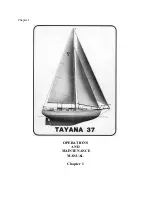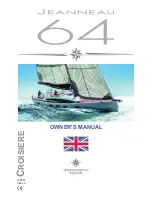
37
SAfETY EQUIpMENT
►
Check public regulations applicable by
law in the region of your operation.
►
Emergency equipment to be carried by
law.
►
Boat documentation and certificates of
proficiency.
►
A life jacket for each person
►
Capsizing line
►
Suitable weather-gear, clothing for poor
and good weather.
►
Air-pump, paddle, repair set and tools.
►
One boat- towing line
►
Spare ropes, lines, straps, shackles, and
tape for emergency repairs.
►
Knife and lighter
►
First aid kit
ANTI COllISION - AND
OvERTAKING RUlES
►
When both boats move with sails on dif-
ferent sides, the starboard boat gives
way to the port boat. That means, the
boat with the sail on the port side has the
right of way.
►
When both boats have the sail on the
same side, the windward boat gives way
to the leeward boat. That means, the
boat closer to the wind gives way to the
downwind boat.
►
When overtaking the overtaking boat
must give way to windward.
►
The boat obliged to give way shall indi-
cate intention clearly, in good time, main-
tain adequate distance, and not cross the
bow of the overtaken vessel.
►
The boat that has the right of way shall
not alter course, unless as an action to
avoid a collision.
QUOTATION fROM SAIlORS
lANGUAGE BOx
Sailors have their own form of expression.
For better understanding, we quote the most
important definitions.
►
Belay – to fasten a line
►
Bow – the forward end of a boat
►
Clew - the rear bottom corner of a sail
►
Foot of a sail – The lower edge of a sail
►
Forestay - the piece of standing rigging, for-
ward of the mast, which keeps it from falling
backwards
►
Gennaker – a large light cloth, asymetrically
and triangular shaped foresail
►
Halyard – the rope by which to pull up a sail
►
Hoist – to raise the sail up the mast.
►
Jib – a small foresail
►
Lanyard – a short thin piece of line
►
Leach – the rear edge of a sail
►
Lee - the downwind side, - (opposite the
windward side)
►
Luff – the forward edge of a sail
►
Mainsheet guide – the transom fitted trian-
gular arranged line allowing the mainsheet
block setting to be set at positions (instead
traveller) to suit.
►
Mast-head – the top of the mast
►
Port – the boats left side, viewed in direction
from behind
►
Rig – the gear above boat deck level, i.e.
mast, stays, shrouds (referred to as standing
rigging, whereas detachables, halyards, li-
nes etc.are classed as running rigging)
►
Sheet - the rope by which to control sails
►
Shroud - the piece of standing rigging hol-
ding the mast up from side to side
►
Starboard - the right side of a boat, viewed
from behind
►
Stern – the rear end of a boat
►
Tack - the forward bottom corner of a sail
You may now get afloat sailing.
May you enjoy sailing your HAPPY CAT, and
always safely get to your destination.
More informations
www.happy-cat.at/infos/
liday- and bathing activities take place.
►
Sailboats though must give way to public
service vessels, priority vessels, those
moving in convoy, vessels of restricted
manoeuvrability, and fishing vessels.




































